Get Tech Tips
Subscribe to free tech tips.
Lifting Techniques Part 5 – Really HEAVY Stuff
This is Part 5 of a series by Senior Refrigeration Tech (and prolific writer) Jeremy Smith. Pay attention to this one, folks. I know rigging and safe lifting practices may be boring to some of you, but it could very well save your back or your life.
Disclaimer
This article is written by a technician representing his real-world experiences and his advice for best practices. You MUST understand the particular application, the weight of materials, and the load strength of every item you use, from struts to pulleys to anchors, ladders, ropes, etc. HVAC School is NOT giving OSHA-approved safety advice. Refer to your managers, safety professionals, and OSHA guidelines first and foremost. Apply any and all of these practices at your own risk with the knowledge that we are trying to help keep you from hurting (or killing) yourself.
Heavy stuff and getting creative, safely
All right, we've got the basics down. Knots are no problem; rigging up a 100-pound compressor is a piece of cake, and the boss has started to send you on those heavy lifting jobs because you can confidently do them easier, faster, and more safely than your coworkers. Then he drops the bomb on you…
Next week, he needs you to change out another compressor. The catch? It's a 25 HP Copeland 4D model. A big girl. A compressor like that weighs about 450 pounds. This isn't the time for ropes and pulleys; we need to get some serious hardware out.
Enter chain hoists and chain falls.
Now, if it needs to go onto a roof, DO NOT use these methods unless there is absolutely no alternative. I've used them on second-floor indoor lifts, but if you can use a crane, USE A CRANE. I worked to develop these techniques to fill the gap between compressors like the big 4D where a crane isn't a question and something like a 9000-BTUH mini-split compressor that doesn't weigh but 20 pounds or so and to help in the final positioning of that machine.

Now, we can lift some stuff…
Not so fast. We still have to connect to it. Up until now, the forces involved haven’t been enough to bend or break lifting hardware. However, with loads weighing hundreds of pounds and the real possibility of putting angular stress on components, we need to talk about lifting eyes, shackles, chains, straps, and some other fun stuff.
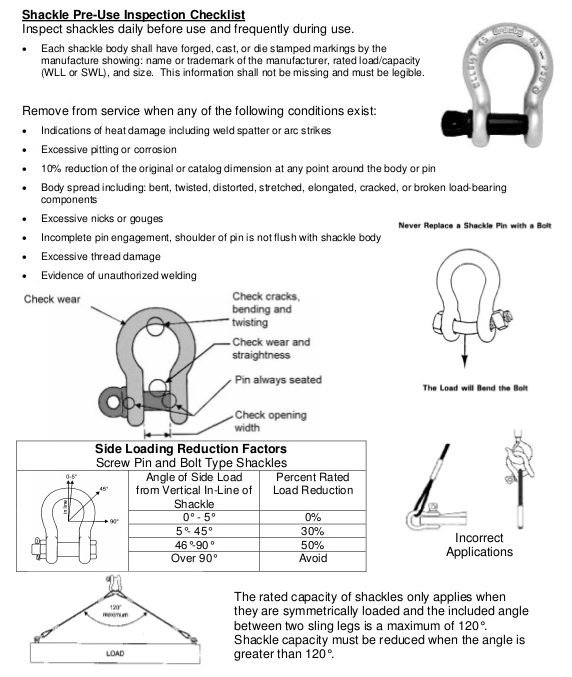
Lifting eyes are exactly that. They are designed to have force applied to them in a certain way. If force is applied in the wrong direction, the bolt can bend or break. Force is ideally exerted straight up and down. If that force needs to be applied at an angle, you need to back up a step and slow down. Can you figure a better way to do the job? Is there a better way to hook up the load to avoid stressing the bolt in that direction? If not, there are 2 basic rules for using that eyebolt with angular force applied:

#1. Keep the force applied in the plane of the eye. Pulling sideways on the eye will bend it.
#2. Don’t let the force angle go past 45°

Before we move on from eye bolts, we should mention a few more things. There is a difference between a plain eye bolt and a shouldered eye bolt. Use the shouldered eye bolt. It’s stronger and is designed to be used for lifting, especially if you need to put any angular force on it. Also, when installing an eye bolt, it needs to be tightened properly and of proper length. If the eye bolt is sticking way out of the threads for it, it allows the applied force to bend that bolt much more easily.
Chains vs. Straps
Frequently, I find myself setting up complicated lifts that require multiple anchor points. For making anchors, particularly around structural steel or unit framework, I prefer to use short lengths of chain and shackles. The length of the chain tends to be almost self-centering once a little force is applied to it, and the shackle is a good anchor for whatever machine I'm using to lift or pull with. Straps are handy to have around but, as my skills in this area have developed, I've come to find that most lifting straps have a degree of stretch to them which can make precise positioning difficult and, when I've got a 600-pound motor in the air and am trying to lift it a fraction of an inch just to clear a mounting bolt or to slide a shim in place, I don't want any variables that I can't control. The chain doesn't stretch. It's just one less thing to worry about while that load is in the air.
Now, we can start getting to work. I carry 2 or 3 ¼ ton lever chain hoists on the truck and have a ¾-ton lever hoist and a 1-ton chain fall easily accessible for larger lifts. Some guys use a cable puller or a come-along to lift with, and I did so for a lot of years, but those types of devices aren't ideal for that purpose. This is where things kind of leave the realm of what can be taught or explained. I can't necessarily design or explain how to build a gantry or lifting system to move a compressor to a place that I've never seen. Look around. Use structural steel, unit framing, unistrut, and threaded rod to create a custom lifting gantry. Here are some examples of site-built rigs I've used to change out compressors.
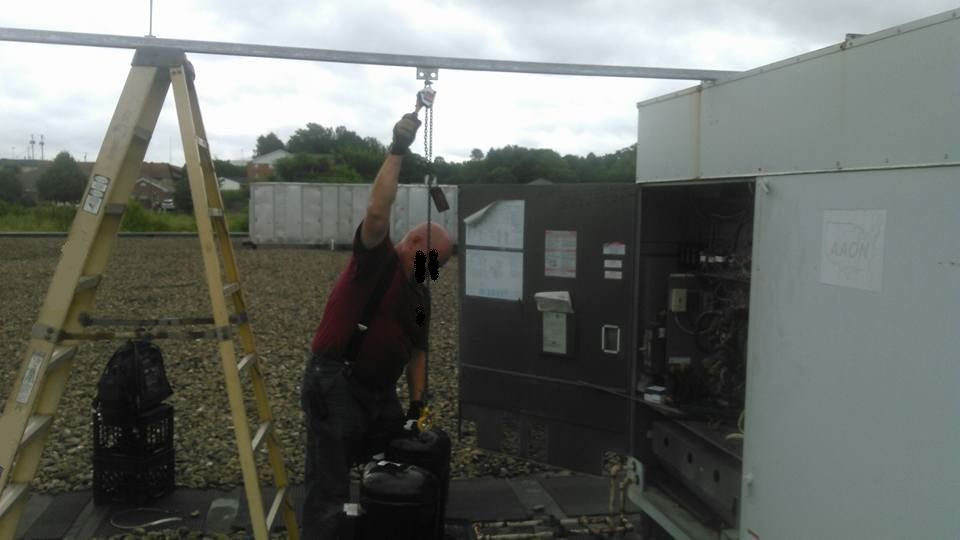
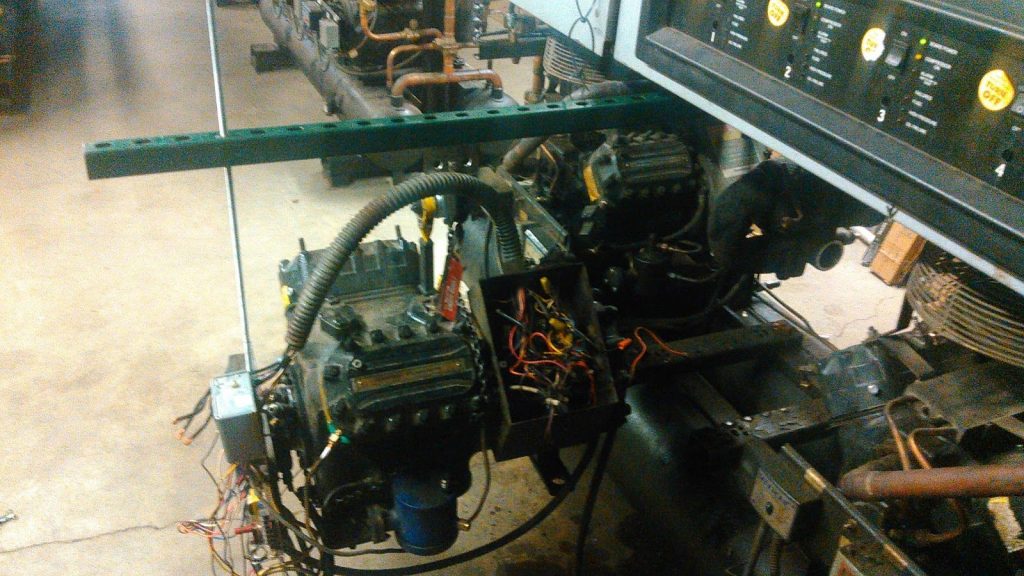
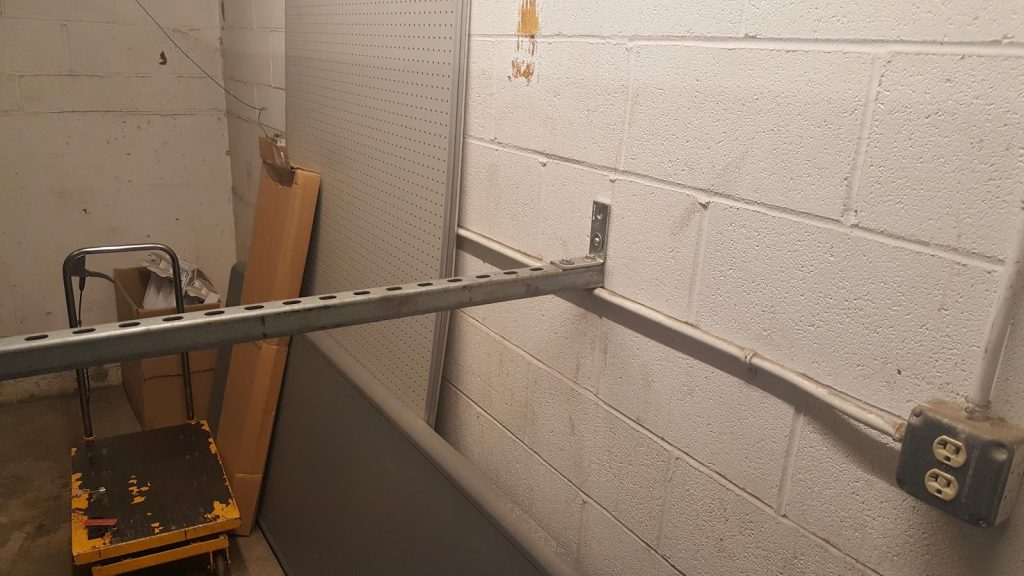

Note that the unistrut is bolted to the top of the ladder to prevent falling. Creativity and stability are key here. Go slowly and be very careful lifting loads. Very often, you don’t have to lift the load many feet in the air, but only a fraction of an inch to get it to clear whatever is holding it. Then, with the trolley, it will slide easily out of place and back in again…
Getting Creative
A challenge that was posed to me was to set up a rigging system to take a 30-HP compressor from ground level to the second floor up a flight of stairs without touching a step. Someone in the past had made something like a pair of skis out of unistrut and dragged the compressor up the steps using that setup. This broke the edges off of several steps and created trip hazards. Take a couple of minutes and consider this challenge. Come up with your plan.
Now, here is how I did it.
At the top of the staircase, I had a piece of unistrut wedged into the structural steel—a solid anchor point. I went to the ceiling above the bottom of the stairs and installed another anchor point. At the bottom of the stairs, I installed a small anchor point away from the bottom of the steps.
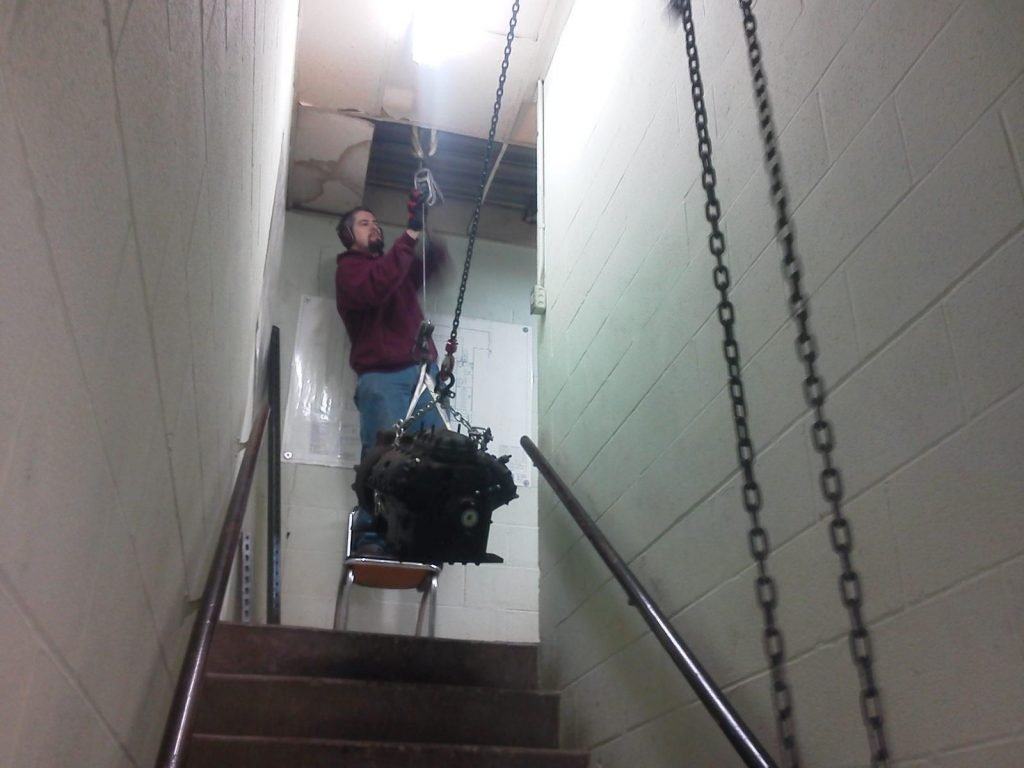
At the top of the stairs, I set up a 1-ton chain fall. Above the bottom of the stairs, I set up a come-along (I know I said they aren't ideal. They aren't. It's just what I had to work with), and I set up a small chain hoist between the bottom of the steps and the anchor. In practice, each hoist was connected to the load. Start by pulling the load back, away from the steps. Now, start taking up the weight with the hoist above the base of the steps until it is high enough to clear the steps. Let out the small hoist and disconnect it. Now, start swinging the load up the staircase using the chain fall, adjusting the height as necessary with the other hoist. This basic technique is one that I use frequently. I've called it “the trapeze” or “pick and swing.” To be honest, I don't know if it has a formal name, but it's a very useful lifting technique to have in your toolbox. A variant of this idea is using one hoist primarily to lift the load and two hoists to steer the load into place.
Thanks for sticking with me through this. I hope that you’ll take these techniques, adapt and apply them to your own needs. Hopefully, you’ve found something in this to help to prevent injury and to make those bigger jobs a little easier.
—Jeremy
Shopping list
Roughneck Manual Lever Chain Hoist – 1/4-Ton Capacity, 12in. Head Room
Lever Block Chain Hoist 3/4 Ton 1650 lbs Capacity, 5′ Lift – Tec-union
1-ton chain fall











Comments
semi shady, but seeing as i used to work.for a company that threw you to the wolves and had to do.much of the same, i agree, that with no better alternatives, i too, would use many of the same methods.
semi shady, but seeing as i used to work.for a company that threw you to the wolves and had to do.much of the same, i agree, that with no better alternatives, i too, would use many of the same methods.
Well written and informative. I don’t find this stuff boring at all, planning and executing a big heavy lift is one of my favorite parts of the job.
Well written and informative. I don’t find this stuff boring at all, planning and executing a big heavy lift is one of my favorite parts of the job.
What are you using inside track of Unistrut for the trolley?
What are you using inside track of Unistrut for the trolley?
To leave a comment, you need to log in.
Log In